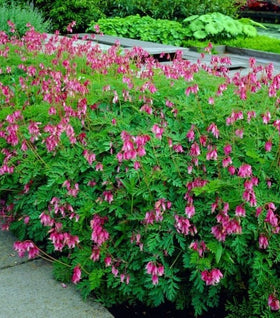Bleeding Heart Plants for Sale Online
Bleeding Hearts, also known as Dicentra, light up shady areas of the garden with their slender stems and easily recognizable heart-shaped blossoms. There are two types of Bleeding Heart plants, the larger type; Dicentra spectabilis with their tall, thin, arching stems that bloom in the spring, and the smaller "fern-like foliage" type, Dicentra luxuriant, that blooms all summer.
Bleeding Hearts make fantastic companion plants for ferns, hostas, astilbe in the shade garden. Bleeding hearts are deer resistant and very hardy, making them perfect for growing in even the country's northern areas.
Buy Dicentra Online
Bleeding Hearts have been an old-time favorite in ornamental gardens for years. These beautiful plants have soft green foliage and drooping rose pink and white heart-shaped flowers in the spring and attract hummingbirds to the garden. Dicentra spectabilis can form clumps up to 3 feet across. The foliage of pink bleeding heart plants goes dormant in summer when the heat sets in but reemerged in the fall as temperatures cool.
Choosing an Area to Grow Bleeding Heart Plants
Dicentra plants prefer to grow in partial to full shade, in well-drained, slightly acidic to neutral soil. They thrive in woodland soils so the addition of compost is recommended. The beautiful flowers are delicate so select a site for them that is sheltered from high winds.
Fertilizing Bleeding Heart Plants
When initially planting dicentra plants we recommend adding Bio-tone Starter Fertilizer as it will add life to the soil replicating the natural environment that Dicentra Plants are native to. Fertilize dicentra plants each spring by working a balanced granular fertilizer into the soil around the base of the plants being careful not to disturb the delicate roots which are just below the soil surface. Keep the ground consistently moist during the growing season as bleeding hearts prefer constant moisture.
When to Cut Back Bleeding Heart Plants
The delicate foliage can be cut back to ground level when it begins to turn yellow in summer.
Propagating Bleeding Heart Plants from Seed
Bleeding Heart plants can be grown from seed collected in your own garden. Fresh seed should be sown right away in trays and allowed to stay outside for the winter months in a cold frame or unheated porch. If you cannot sow your seeds right away, you can germinate them indoors and transplant them in spring.
To do this, store the seeds in the freezer for several weeks in moist perlite or potting soil. This replicates the natural cycle of winter for the cold period. Allow the seeds several weeks to germinate in a moist potting mix at temperatures around 60 degrees Fahrenheit.
Propagating Bleeding Heart Plants by Division
Another method of propagating bleeding heart plants is by division. Bleeding hearts react well to division and grow much better if divided every 5 years or so. Dig up the plant carefully and remove the soil from the root system with water. Use a sharp, clean serrated knife to cut the plant in half or thirds.
Each portion should immediately be planted in loose garden soil or in containers and kept moist. Root division is not necessary but can be done in the spring to propagate new plants.
Pests and diseases of Bleeding Heart Plants
Bleeding heart plants have no serious insect or disease problems, but occasionally can be attacked by aphids which are easily handled by insecticidal soap. The plants may develop root rot if the soil is too wet for extended periods so be sure to site your plants in areas where water does not pool for extended periods.



